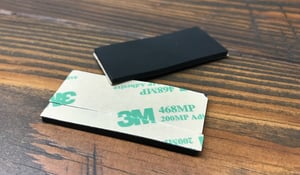If you’ve ever had to source polyurethane foam, you’ll want to tear out your hair after hours hopping from one material page to the next. This time, take a moment to ask, What are my material requirements, and how can I compare PORON foams most effectively?
Polyurethanes are the largest class of polymers worldwide, and even their subcategories like PORON brand foam have many design variations.
Strouse has helped prototype hundreds of parts using different variations of foam tape, meaning we know how to find the right variation to match our customer’s needs.
As we examine these types of PORON foam, you’ll learn their purpose and what factors you should consider before making any final product decisions.
What is Rogers Poron Foam?
PORON foam is a microcellular urethane with high compression set resistance and high energy absorption. Its open-cell design allows for greater resiliency and longevity, even after multiple impacts.
The Rogers Corporation, the creator of PORON, has patented thirty-five PORON Industrial Polyurethanes. Each of their products utilizes PORON urethane foam's distinct properties to different ends. These open-cell polyurethane materials have solved many notable engineering challenges, including filling gaps in the Hubble space telescope.
PORON foam is meant to keep its shape, cushioning, and contouring precisely in response to pressure. These viscoelastic properties are derived from the foam’s microcellular design. Once the pressure is released, the cushioning foam expands to its full size or until it meets a new obstacle—a method of creating physical memory.
Open-Cell vs. Closed-Cell Foam
PORON foam's defining trait is its open-cell design. Before its invention, the most popular type of memory foam used a closed-cell design.
Closed-cell polyurethane foams are filled with tiny, closed air bubbles or pockets that allow them to use air to cushion. Over time, repeated compression causes air to leak out of the closed cells. Because the cells shut it out, air cannot return to the foam. This process of exhalation deflates the foam.
In contrast, open-cell designs are more akin to microcellular springs. Compression lets the polyurethane springs condense, and air moves freely from the space. Meanwhile, the remaining air can support the pressure point within the micro-coils. After the pressure eases, air can easily flow back into the open cells and -re-inflate the foam. The foam expands, and both air and polymer support the pressure point.
Because open-cell design prevents deflation over time, PORON foam is frequently used in products designed to resist frequent, repeated impact. Running shoes and prosthetic limb interiors are good candidates for PORON foam and other open-cell polyurethane cushions.
Each PORON foam variety uses the same open-cell design to different ends. Some PORON foam products are more thermal resistant and thus make high-quality battery insulators. Others are lightweight and well-suited for absorbing sound waves. Therefore, the type of PORON you choose is very situation-dependent.
Types of PORON Foam and Their Advantages
When working with long-term tape for your projects, you'll want to ensure you choose the correct adhesive for the job. Let’s review eleven different types of PORON foam so you can see which might work for your project.
| Name | Density | Thickness | Temperature | Pros | Cons |
|---|---|---|---|---|---|
| PORON 4701-15 (SOFT SEAL) | 104 kg/m³ (lowest possible) | 0.53 to 1.00mm | -40°C to 90°C | • Excellent dust seal to block out small particles • Cushions small, delicate materials and components • Relatively soft and holds shape well |
• Not recommended for shock absorption in vehicles • Won't withstand high compression forces |
| PORON POLYURETHANE 4701-30 SERIES | 320 or 400 kg/m3 | 0.79 to 12.7 mm | -51 to 121° C | • Highly durable, flexible, and compression set resistant • Absorbs sound waves and shock waves well • Useful in delicate applications (cushioning batteries or electronics) |
• Isn't suited to frequent temperature fluctuations • Not very dense, not for heaviest-duty applications • Not suited for dampening industrial noise |
| PORON® AQUAPRO™ 4701-37 SERIES | 304 kg/m³ to 400 kg/m³ | 0.15 to 12.7 mm | 40°C to 90°C | • Long-lasting (retains set compression, doesn't corrode) • Environmentally safe with zero risks of plastic migration • Doesn't require significant compression force to achieve tight seal • Flame-retardant and automotive chemical-resistant |
• Might not be suited to high-heat applications • Not the most shock-absorbent • Not recommended for maximum-impact scenarios |
| PORON 4701-40 POLYURETHANE | 240 kg/m³ to 480 kg/m³ | 0.79 to 12.7mm | -40°C to 90°C | • Handles temperature fluctuations without warping • Density and tensile strength make it well-suited to shock absorption • Absorbs and diffuses mechanical shocks, drops, and vibrations |
• Not notably waterproof or anti-bacterial (sealing not ideal) |
| PORON AQUAPRO™ SERIES FOAM | 224 kg/m³ | 0.15 - 12.7mm | 40°C to 90°C | • Resists most chemicals • Safe for the environment (low outgassing) • Durable for long-term performance • Meets low closure-force requirements in specific aviation applications |
• Doesn't revert to expanded state after vacuum sealed • Cannot be reused for other applications |
| PORON 4701-50 POLYURETHANE | 240 kg/m³ to 480 kg/m³ | 0.30 to 12.7 mm | -40°C to 121°C | • Firm and somewhat dense polyurethane (less give than softer foams) • Resists moderate impacts and cushions or absorbs intense impacts • Ample durability, longevity, and energy efficiency |
• Isn't soft • Does not resist all chemical fluids (will swell depending) |
| PORON 4701-60 POLYURETHANE | 240 kg/m³ to 480 kg/m³ | 0.79 to 6.35 mm | -16°C to 90°C | • Firm and resilient enough to seal hot machinery • Absorbs frequent, high-intensity shock or sound waves • Resists tearing, corrosion, mildew, and bacteria |
• Not soft • Unsuitable for cushioning human body or delicate electronics • Not recommended to fill small gaps (can't expand precisely) |
| PORON V-0 FOAM | 400 kg/m³ | 5 and 6 mm | -20°C to 90°C | • Safest PORON foam for humans • Surpasses high standards for flame-resistance and durability • Firm and easy to die cut with precision (will retain shape long after) |
• Isn't very soft or flexible • Not well-suited to damp areas |
| PORON SHOCK SEAL™ FAMILY | 240 kg/m³ to 480 kg/m³ | 0.53 to 1 mm (Handheld) 1.57 to 12.77 mm (Industrial) |
-38°C to 90°C | • Firm and easy to shape and contour • Absorbs huge shock sound waves and dampen high-decibel sound • Effectively mitigates frequent, intense, or unpredictable shocks |
• Too firm to be any good for gap-filling • Not waterproof nor flame retardant • Not recommended in cars, aircraft, or electric vehicles |
| PORON 4790-92 POLYURETHANE FOAM | 144 kg/m³ to 480 kg/m³ | 0.53 to 12.7mm | -20°C to 121°C | • Extra soft with extended life • Lightweight • Absorbs low-energy impact vibrations • Bacterial and mildew resistant (damp-environment friendly) |
• Not suitable for large-scale noise or vibration management • Tends to swell when it absorbs water (cannot be submerged) • Not particularly resistant to automotive fluids |
| PORON EVEXTEND® 4701-43 | 112 kg/m³ to 320 kg/m³ | 1 to 3 mm | -20°C to 90°C | • Durable polymer with a long life • Effective shock absorption where low-density materials are mandatory • Halogen-free and UL-certified as flame-resistant |
• Not waterproof • Has a highly specific utility • Typically best for interfacing EV batteries |
1. PORON 4701-15-06 (SOFT SEAL)
The PORON soft seal series offers reliable and durable materials to use in thinner designs. It's easy to process, good for long-term protection, and good for dust sealing.
2. PORON POLYURETHANE 4701-30 SERIES
The impact foam PORON XRD is part of the 4701-30 series and lightweight enough to fit into apparel. This series encompasses both PORON 4701-30-20 and PORON 4701-30-25.
3. PORON® AQUAPRO™ 4701-37 SERIES
This series was designed to protect components from potential water damage and to seal contained water. The PORON AquaPro Series uses PORON's expansive, space-filling properties and bolsters them with water-resistant capabilities. The PORON® AquaPro™ Series includes 4701-37 Thin, 4701-37-14, 4701-37TS9-19, and 4701-37TS9-25.
4. PORON 4701-40 POLYURETHANE
This polyurethane foam series is composed of the second softest PORON foams. Some of its softness is traded for higher tensile strength than the 4701-30 series. The PORON 4701-40 Polyurethane series encompasses 4701-40-15, 4701-40-20, and 4701-40-30.
5. PORON AQUAPRO™ CLOSED-CELL VACUUM SEAL 4701-41
This PORON foam product line differs from everything else on this page because it is the only closed-cell foam. They're intended to be vacuum-compressed and create a solid, airtight seal upon compression. This series includes PORON AquaPro™ 4701-41-15, 4701-41-20, and 4701-41-30.
6. PORON 4701-50 POLYURETHANE
The PORON 4701-50 line of polyurethane foams is firm. These foams are made for high-impact, high-energy gaskets. They have a high compression set deflection rating and are denser than other PORON foams.
7. PORON 4701-60 POLYURETHANE
The PORON 4701-60 is a very firm series of PORON foam and one of the most durable PORON products. It can deflect waves and vibrations for an extended period without losing shape or stiffness. It also resists tearing, corrosion, mildew, and bacteria. The series encompasses 4701-60-15, 4701-60-20, and 4701-60-25.
8. PORON V-0 FOAM
PORON V-0 foam is both HBF and UL94-V-0 certified for passenger safety.
9. PORON SHOCK SEAL™ FAMILY
The PORON Shock Seal™ Family of foams includes 4790-79-09, 4790-79-12, 4790-79-15, and 4790-79-20. Rogers Corporation sometimes categorizes these foams as "display back pad foam." It is also flexible. The combination of firmness and flexibility allows it to absorb impacts precisely, even in a small space.
10. PORON 4790-92 POLYURETHANE FOAM
The PORON 4790-92 series is made of extra-soft foam. It rebounds slowly after any pressure is released.
11. PORON EVEXTEND® 4701-43
The PORON EVExtend® is a material intended to cushion the batteries of electric vehicles. Its most unique property is its flatter compression force deflection (CFD) curve.
This flatter curve works with the battery's natural cycle of contraction and expansion. To absorb and distribute force effectively when the degree of compression is constantly changing, the Rogers Corporation developed foam with a firm-to-soft gradient in each individual piece.
These materials are firmer at the front to maximize their impact-absorbing effects in the direction most impacts come from. The softer back slowly expands to cushion the battery. Due to this gradient, the PORON EVExtend® has no consistent density throughout.
Finding the Right PORON Foam
Each type of PORON polyurethane has advantages, so which PORON foam do you need? Foam suppliers will recommend a range of products based on your project; however, if you’re seeking a custom part component, you may want to reach out to a converter first.
Die cut PORON foam can be customized to your project's exact needs while maintaining the efficiency of mass production. Depending on your intended use case, a material converter can help you find an easily manufacturable solution.
If you’re interested in trying out different types of PORON foam for your design, contact Strouse for custom samples. If you’re curious about other types of foam, you can learn more about foam tape and other adhesive materials in our Learning Center.
Originally published: August 8, 2022







